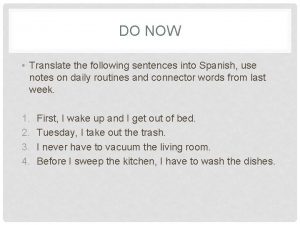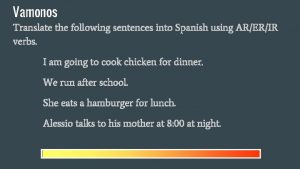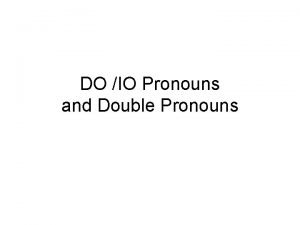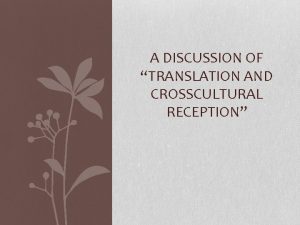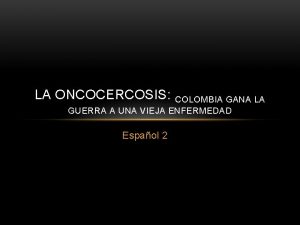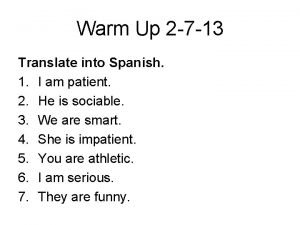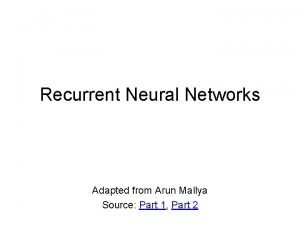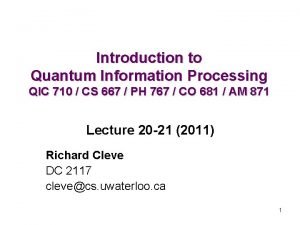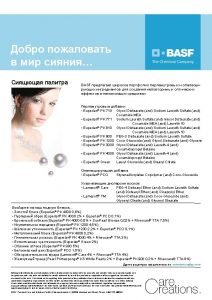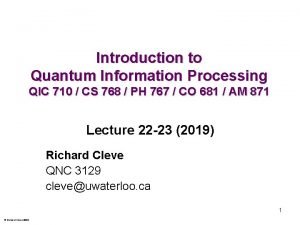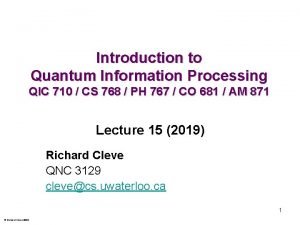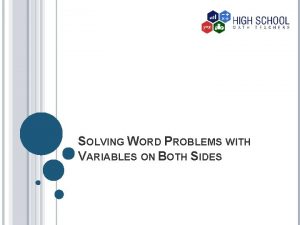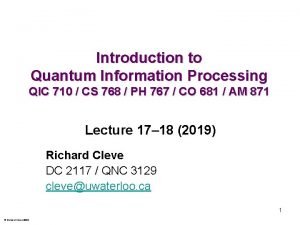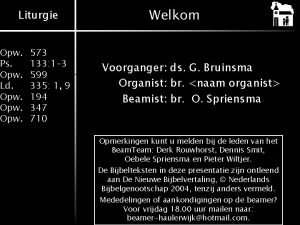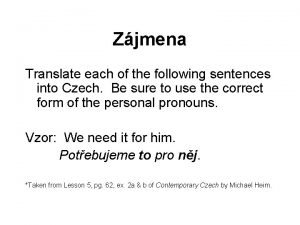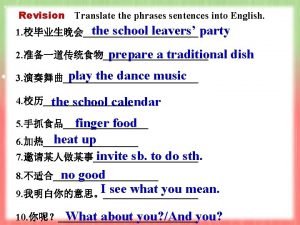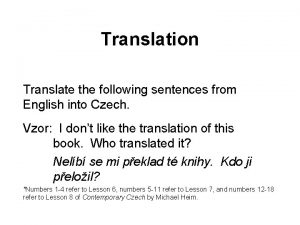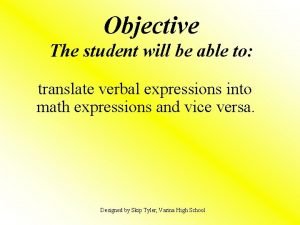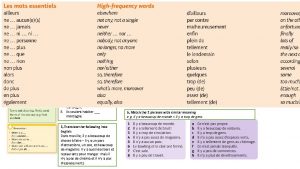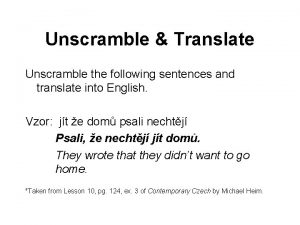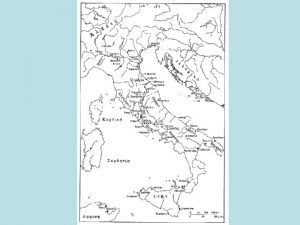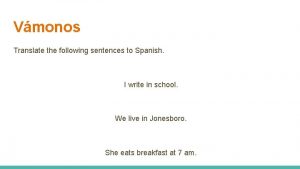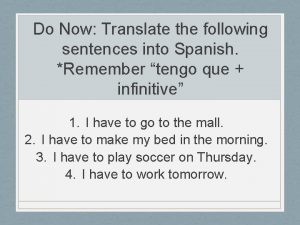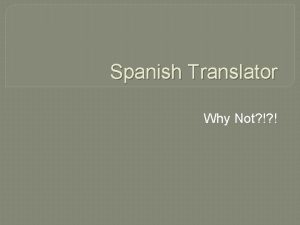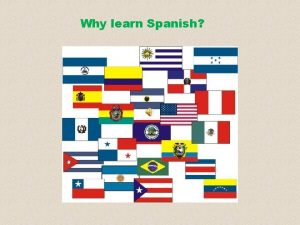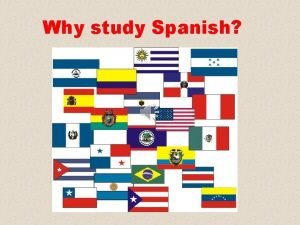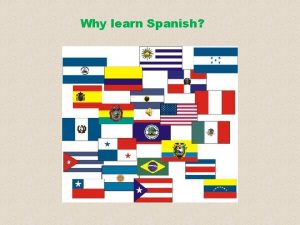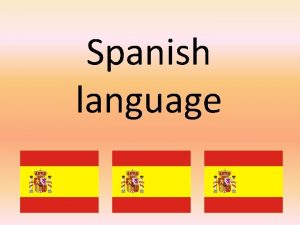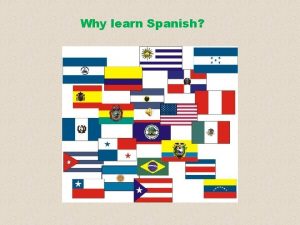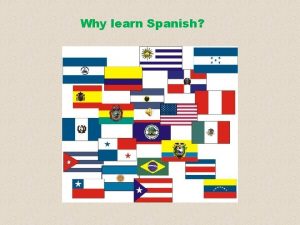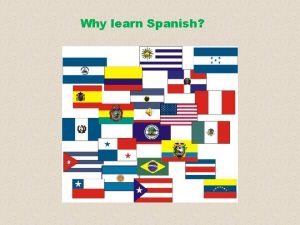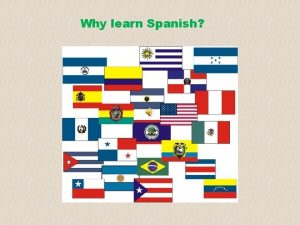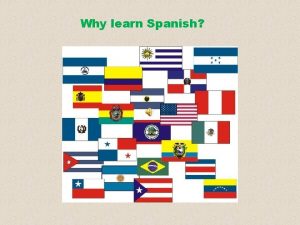710 Translate the following to Spanish I He



































- Slides: 35

7/10 Translate the following to Spanish. -I - He - She - we (feminine) - You all (informal, used in Spain) - They (masculine/ mixed)

CONJUGATING SER C

Let’s talk about verbs! • He goes to the store. • She walks to the post office. • We draw the dog. • She draws the cat.

Notice how the verb changes when we use a different subject? • We draw the dog. • She draws the cat. • I am a friend of hers. • She is a friend of mine. • We are friends.

• “am”, “is”, “are” are all forms of the verb “to be” • “to be” is what we call the infinitive, that is: it’s unconjugated.

• In Spanish we learn the infinitive form of the verb and then we learn how to conjugate it with a chart.

• In Spanish, the verb “to be” is “ser” • “ser” is the infinitive form, there is no word “to” in front of it. It is part of the meaning.

Setting up charts to memorize verbs. yo

Setting up charts to memorize verbs. yo tú

Setting up charts to memorize verbs. Usted will be with third person because it uses the same verb form yo tú usted, él, ella

Setting up charts to memorize verbs. yo tú usted, él, ella nosotro s(as)

Setting up charts to memorize verbs. yo tú usted, él, ella nosotro s(as) vosotro s(as)

Setting up charts to memorize verbs. Ustedes will also be placed in 3 rd person. yo tú usted, él, ella nosotro s(as) vosotro s(as) ustedes, ellos (as)

Setting up charts to memorize verbs. yo tú usted, él, ella soy nosotro s(as) vosotro s(as) ustedes, ellos (as)

Setting up charts to memorize verbs. yo soy tú eres usted, él, ella nosotro s(as) vosotro s(as) ustedes, ellos (as)

Setting up charts to memorize verbs. yo soy tú eres usted, él, ella es nosotro s(as) vosotro s(as) ustedes, ellos (as)

Setting up charts to memorize verbs. yo soy tú eres usted, él, ella es nosotro somos s(as) vosotro s(as) ustedes, ellos (as)

Setting up charts to memorize verbs. yo soy tú eres usted, él, ella es nosotro somos s(as) vosotro sois s(as) ustedes, ellos (as)

Setting up charts to memorize verbs. yo soy tú eres usted, él, ella es nosotro somos s(as) vosotro sois s(as) ustedes, son ellos (as)

What happens when a pronoun isn’t used? • Juan • Daniela y Sandra • Daniela y yo • Juan y tú

What happens when a pronoun isn’t used? Think about the point of view and how many. • Juan es (Juan would be él) • Daniela y Sandra • Daniela y yo • Juan y tú

What happens when a pronoun isn’t used? Think about the point of view and how many. • Juan es (Juan would be él) • Daniela y Sandra son (ellas) • Daniela y yo • Juan y tú

What happens when a pronoun isn’t used? Think about the point of view and how many. • Juan es (Juan would be él) • Daniela y Sandra son (ellas) • Daniela y yo somos (nosotros) • Juan y tú

What happens when a pronoun isn’t used? Think about the point of view and how many. • Juan es (Juan would be él) • Daniela y Sandra son (ellas) • Daniela y yo somos (nosotros) • Juan y tú sois (vosotros) OR • Juan y tú son (ustedes)

Remember our phrases that use this verb? • ¿De dónde eres? • Soy de Aiken. • ¿De dónde es Martín? • Él es de Nicaragua • ¿De dónde son Daniela y Sonia? • Ellas son de Miami.

When the subject is obvious, it does not need to be written out. • Soy de Aiken. • Yo soy de Aiken. • Martín es de Honduras. • Es de Honduras.

Remember we also use third person for objects (it). • La casa es grande. • Es grande.

¿De dónde son? Hola, me llamo Lucía. Mi amigo Andrés y yo ____ de la República Dominicana. Yo ___ de Santo Domingo y él _______ de San Pedro de Macorís. La señora Múñoz y el señor Vásquez _____ de Puerto Rico. Son mis maestros favoritos. Mis amigas Laura y Ana ______ de Cartagena. Y tú, ¿de dónde ______?

¿De dónde son? Hola, me llamo Lucía. Mi amigo Andrés y yo somos de la República Dominicana. Yo ___ de Santo Domingo y él _______ de San Pedro de Macorís. La señora Múñoz y el señor Vásquez _____ de Puerto Rico. Son mis maestros favoritos. Mis amigas Laura y Ana ______ de Cartagena. Y tú, ¿de dónde ______?

¿De dónde son? Hola, me llamo Lucía. Mi amigo Andrés y yo somos de la República Dominicana. Yo soy de Santo Domingo y él _______ de San Pedro de Macorís. La señora Múñoz y el señor Vásquez _____ de Puerto Rico. Son mis maestros favoritos. Mis amigas Laura y Ana ______ de Cartagena. Y tú, ¿de dónde ______?

¿De dónde son? Hola, me llamo Lucía. Mi amigo Andrés y yo somos de la República Dominicana. Yo soy de Santo Domingo y él es de San Pedro de Macorís. La señora Múñoz y el señor Vásquez _____ de Puerto Rico. Son mis maestros favoritos. Mis amigas Laura y Ana ______ de Cartagena. Y tú, ¿de dónde ______?

¿De dónde son? Hola, me llamo Lucía. Mi amigo Andrés y yo somos de la República Dominicana. Yo soy de Santo Domingo y él es de San Pedro de Macorís. La señora Múñoz y el señor Vásquez son de Puerto Rico. Son mis maestros favoritos. Mis amigas Laura y Ana ______ de Cartagena. Y tú, ¿de dónde ______?

¿De dónde son? Hola, me llamo Lucía. Mi amigo Andrés y yo somos de la República Dominicana. Yo soy de Santo Domingo y él es de San Pedro de Macorís. La señora Múñoz y el señor Vásquez son de Puerto Rico. Son mis maestros favoritos. Mis amigas Laura y Ana son de Cartagena. Y tú, ¿de dónde ______?

¿De dónde son? Hola, me llamo Lucía. Mi amigo Andrés y yo somos de la República Dominicana. Yo soy de Santo Domingo y él es de San Pedro de Macorís. La señora Múñoz y el señor Vásquez son de Puerto Rico. Son mis maestros favoritos. Mis amigas Laura y Ana son de Cartagena. Y tú, ¿de dónde eres?

8, 9
 Translate the sentences into spanish
Translate the sentences into spanish Translate the following sentences into spanish
Translate the following sentences into spanish Translate the following into spanish
Translate the following into spanish Sentences with take out
Sentences with take out Translate the following sentences
Translate the following sentences Zhōnɡ
Zhōnɡ Translate inglish
Translate inglish Translate the word language in spanish
Translate the word language in spanish Colombia gana la guerra a una vieja enfermedad
Colombia gana la guerra a una vieja enfermedad Translate to spanish
Translate to spanish Cmo se dice
Cmo se dice Arun mallya
Arun mallya Qic 710
Qic 710 What is da pam 710-2-1 used for
What is da pam 710-2-1 used for Euperlan pk 3000
Euperlan pk 3000 A gas has a pressure of 710 kpa at 227
A gas has a pressure of 710 kpa at 227 Qic710
Qic710 Qic 710
Qic 710 Equations word problems with variables on both sides
Equations word problems with variables on both sides Qic 710
Qic 710 452 en yakın yüzlüğe yuvarlama
452 en yakın yüzlüğe yuvarlama Din vde 0100 700
Din vde 0100 700 Opwekking 194
Opwekking 194 Division 2 quartermaster location
Division 2 quartermaster location Ortec 710
Ortec 710 Spanish packet answers
Spanish packet answers Translate
Translate Translate
Translate Translate the phrases
Translate the phrases Translate
Translate Which of the following verbal expression translate x/13
Which of the following verbal expression translate x/13 Translate the following sentences into english
Translate the following sentences into english Các châu lục và đại dương trên thế giới
Các châu lục và đại dương trên thế giới Cách giải mật thư tọa độ
Cách giải mật thư tọa độ Glasgow thang điểm
Glasgow thang điểm ưu thế lai là gì
ưu thế lai là gì
